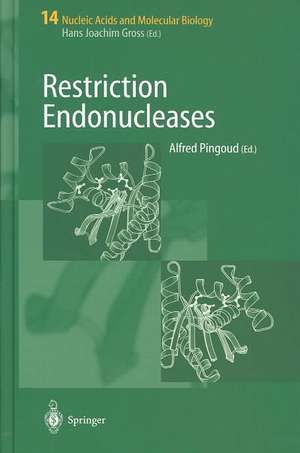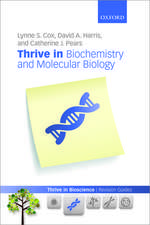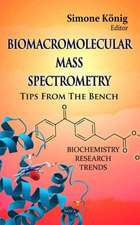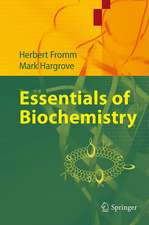Restriction Endonucleases: Nucleic Acids and Molecular Biology, cartea 14
Editat de Alfred Pingouden Limba Engleză Hardback – 19 feb 2004
| Toate formatele și edițiile | Preț | Express |
|---|---|---|
| Paperback (1) | 1219.61 lei 6-8 săpt. | |
| Springer Berlin, Heidelberg – 21 sep 2012 | 1219.61 lei 6-8 săpt. | |
| Hardback (1) | 1231.32 lei 6-8 săpt. | |
| Springer Berlin, Heidelberg – 19 feb 2004 | 1231.32 lei 6-8 săpt. |
Din seria Nucleic Acids and Molecular Biology
- 18%
 Preț: 1111.53 lei
Preț: 1111.53 lei - 18%
 Preț: 1003.38 lei
Preț: 1003.38 lei - 15%
 Preț: 639.41 lei
Preț: 639.41 lei - 15%
 Preț: 647.08 lei
Preț: 647.08 lei - 15%
 Preț: 642.68 lei
Preț: 642.68 lei - 15%
 Preț: 642.36 lei
Preț: 642.36 lei - 18%
 Preț: 1822.76 lei
Preț: 1822.76 lei - 20%
 Preț: 990.62 lei
Preț: 990.62 lei - 18%
 Preț: 956.99 lei
Preț: 956.99 lei - 15%
 Preț: 637.28 lei
Preț: 637.28 lei - 5%
 Preț: 1102.31 lei
Preț: 1102.31 lei - 18%
 Preț: 1218.17 lei
Preț: 1218.17 lei - 18%
 Preț: 947.98 lei
Preț: 947.98 lei - 18%
 Preț: 1384.26 lei
Preț: 1384.26 lei - 18%
 Preț: 1227.52 lei
Preț: 1227.52 lei - 18%
 Preț: 1228.29 lei
Preț: 1228.29 lei - 18%
 Preț: 1225.79 lei
Preț: 1225.79 lei - 18%
 Preț: 942.13 lei
Preț: 942.13 lei - 18%
 Preț: 1222.62 lei
Preț: 1222.62 lei - 18%
 Preț: 950.03 lei
Preț: 950.03 lei - 18%
 Preț: 1216.02 lei
Preț: 1216.02 lei - 18%
 Preț: 953.20 lei
Preț: 953.20 lei - 18%
 Preț: 949.73 lei
Preț: 949.73 lei - 15%
 Preț: 646.30 lei
Preț: 646.30 lei - 18%
 Preț: 895.27 lei
Preț: 895.27 lei - 18%
 Preț: 1004.36 lei
Preț: 1004.36 lei - 18%
 Preț: 894.34 lei
Preț: 894.34 lei
Preț: 1231.32 lei
Preț vechi: 1501.62 lei
-18% Nou
Puncte Express: 1847
Preț estimativ în valută:
235.64€ • 255.87$ • 197.94£
235.64€ • 255.87$ • 197.94£
Carte tipărită la comandă
Livrare economică 22 aprilie-06 mai
Preluare comenzi: 021 569.72.76
Specificații
ISBN-13: 9783540205029
ISBN-10: 3540205020
Pagini: 472
Ilustrații: XXVI, 443 p.
Dimensiuni: 155 x 235 x 34 mm
Greutate: 0.84 kg
Ediția:2004
Editura: Springer Berlin, Heidelberg
Colecția Springer
Seria Nucleic Acids and Molecular Biology
Locul publicării:Berlin, Heidelberg, Germany
ISBN-10: 3540205020
Pagini: 472
Ilustrații: XXVI, 443 p.
Dimensiuni: 155 x 235 x 34 mm
Greutate: 0.84 kg
Ediția:2004
Editura: Springer Berlin, Heidelberg
Colecția Springer
Seria Nucleic Acids and Molecular Biology
Locul publicării:Berlin, Heidelberg, Germany
Public țintă
ResearchCuprins
Survey and Summary A Nomenclature for Restriction Enzymes, DNA Methyltransferases, Homing Endonucleases and Their Genes.- Restriction-Modification Systems as Minimal Forms of Life.- Molecular Phylogenetics of Restriction Endonucleases.- Sliding or Hopping? How Restriction Enzymes Find Their Way on DNA.- The Type I and III Restriction Endonucleases: Structural Elements in Molecular Motors that Process DNA.- The Integration of Recognition and Cleavage: X-Ray Structures of Pre-Transition State Complex, Post-Reactive Complex and the DNA-Free Endonuclease.- Structure and Function of EcoRV Endonuclease.- Two of a Kind: BamHI and Bg1II.- Structure and Function of the Tetrameric Restriction Enzymes.- Structure and Function of Type IIE Restriction Endonucleases — or: From a Plasmid that Restricts Phage Replication to a New Molecular DNA Recognition Mechanism.- Analysis of Type II Restriction Endonucleases That Interact with Two Recognition Sites.- The Role of Water in the EcoRI—DNA Binding.- Role of Metal Ions in Promoting DNA Binding and Cleavage by Restriction Endonucleases.- Restriction Endonudeases: Structure of the Conserved Catalytic Core and the Role of Metal Ions in DNA Cleavage.- Protein Engineering of Restriction Enzymes.- Engineering and Applications of Chimeric Nucleases.
Textul de pe ultima copertă
Restriction enzymes are highly specific nucleases which occur ubiquitously among prokaryotic organisms, where they serve to protect bacterial cells against foreign DNA. Many different types of restriction enzymes are known, among them multi-subunit enzymes which depend on ATP or GTP hydrolysis for target site location. The best known representatives, the orthodox type II restriction endonucleases, are homodimers which recognize palindromic sequences, 4 to 8 base pairs in length, and cleave the DNA within or immediately adjacent to the recognition site. In addition to their important biological role (up to 10 % of the genomes of prokaryotic organisms code for restriction/modification systems!), they are among the most important enzymes used for the analysis and recombination of DNA. In addition, they are model systems for the study of protein-nucleic acids interactions and, because of their ubiquitous occurence, also for the understanding of the mechanisms of evolution.
The present book deals with all aspects of restriction endonucleases including nomenclature, diversity, evolution, genetics, structure and function, mechanism of target site location and DNA recognition, enzymology, protein design, and provides a description of the history of the discovery of and the research on restriction enzymes.
The present book deals with all aspects of restriction endonucleases including nomenclature, diversity, evolution, genetics, structure and function, mechanism of target site location and DNA recognition, enzymology, protein design, and provides a description of the history of the discovery of and the research on restriction enzymes.
Caracteristici
First book dealing with all aspects of restriction endonucleases Includes supplementary material: sn.pub/extras











